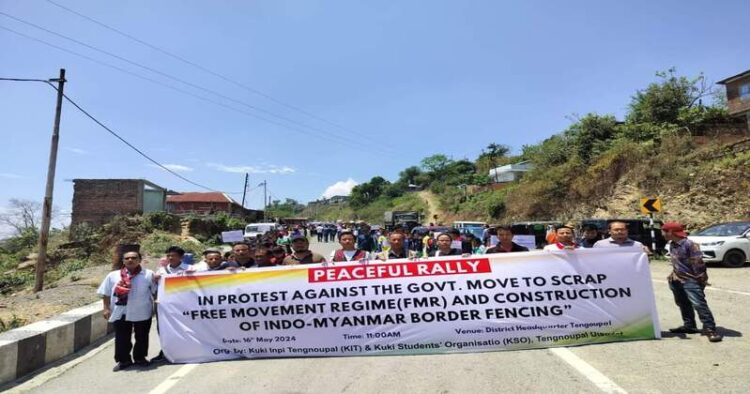Guwahati: It is by now a known fact that the open border with Myanmar has caused a lot of trouble to India’s North Eastern states, especially to states like Manipur. The recent spat of violence which boiled Manipur for several months, has a straight connection with the open border with Myanmar. Be it illegal drug trafficking or illegal arms smuggling, the open border is a major cause of security concern for Indian authority. Besides this the open border gives the opportunity to numbers of militant organisations of the region a free pass to enter the Indian territory at their wish. Many security agencies have found in their investigations that, during the Manipur violence hundreds of militants crossed over to Indian territory through the open border and caused irreparable damage in Manipur.
Whom will You Vote For : https://survey.organiser.org/
This is not the end, with continuous political and military unrest in Myanmar, thousands of people from the neighbouring country entered Indian territory through the open border in the last 3 years. Around 50 thousand Myanmar nationals are taking shelter in Mizoram, Manipur which is also a matter of serious concern. The Manipur government has repeatedly said that illegal intruders are causing demographic changes in the state and these intruders have set up over 996 illegal villages.
Over 5000 illegal intruders from Myanmar have been identified by the Manipur government so far. Reviewing all these serious issues and keeping in mind the national security, the central government in February 2024 decided to fence the Myanmar border and abrogate the Free Movement Region (FMR) with Myanmar. But the decision to close the open border with Myanmar is not well received by some organisations in Manipur, Mizoram and Nagaland.
The Protests:
On May 16, a colossal rally was organised by the Kuki Inpi Tengnoupal District (KIT) and the Kuki Students’ Organisation (KSO) Tengnoupal District in Manipur, denouncing the government’s decision. The rally, which began at St. Peter’s Church, saw hundreds of Kuki-Zo people from Tengnoupal District joining in, culminating at the office of the Deputy Commissioner Tengnoupal District. Meanwhile, in Mizoram, the Zo Reunification Organisation (Zoro) organised rallies in Zokhawthar and Vaphai villages in Champhai district, drawing thousands of protestors, including many from Myanmar.
Reasons for Protest:
Central to the protests is the decision to dismantle the Free Movement Regime (FMR) and implement border fencing, which has ignited fervent opposition from ethnic communities. At the forefront of the demonstrations, Zoro, a Mizo group advocating for the reunification of Chin-Kuki-Mizo-Zomi tribes, highlights the enduring cultural and social ties that would be jeopardised by the policy changes. The FMR, enabling movement up to 16 km on both sides of the border, has long been perceived as a vital conduit for fostering cross-border connectivity and preserving inter-community relations.
Who is behind the Protest?
Experts in these issues of the region say that Church bodies of the Nagaland, Mizoram and hill areas of Manipur are behind this protest. The Zo Reunification Organisation (Zoro) is controlled by churches and Christian leaders of the region and they are preaching against the fencing and abrogation of FMR in Myanmar border. Sources said that ZORO is planning for a greater christian administrative region comprising Chin-Kuki-Mizo-Zomi tribes of Manipur, Mizoram and Myanmar.
Impact and Opposition:
The decision to fence the India-Myanmar border and lift the FMR has faced staunch opposition from the Mizoram and Nagaland assemblies, as well as civil society organisations and student bodies. Over 34,000 Chin refugees are taking shelter in Mizoram following the military coup in Myanmar. And the Mizo bodies are even against the deportation of these refugees. Citing their relation of roots these organisations are in favour of free movements between the two countries despite various security threats posed by the open border.
The protests in Mizoram and Manipur reflect the deep-seated concerns of a certain sections and opposition to the government’s border policy. As tensions escalate, it remains to be seen how authorities will address the grievances of the affected communities and navigate the complex socio-political dynamics of the region.



















Comments